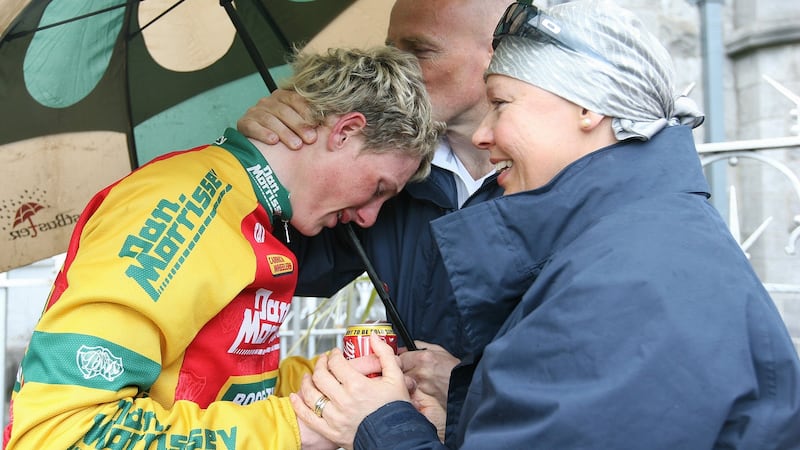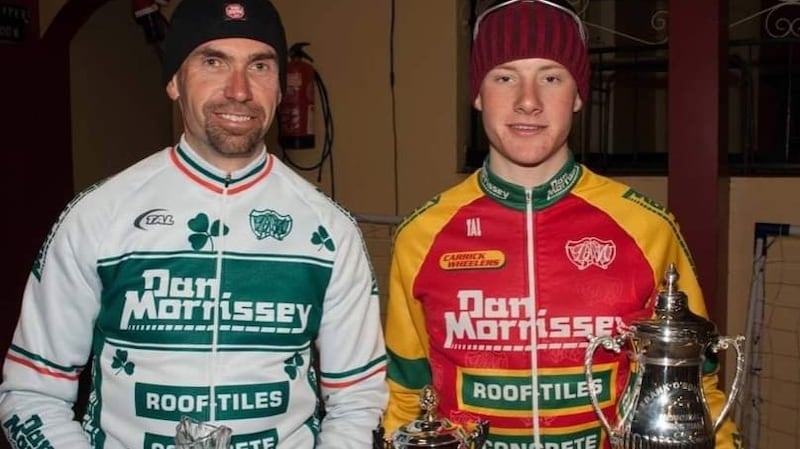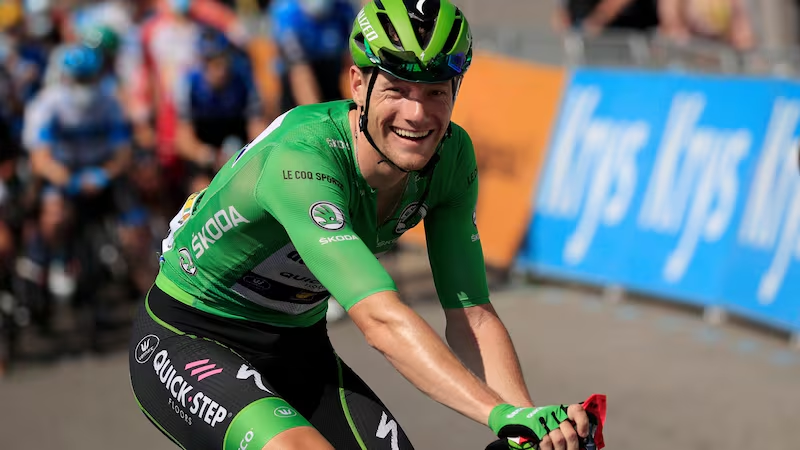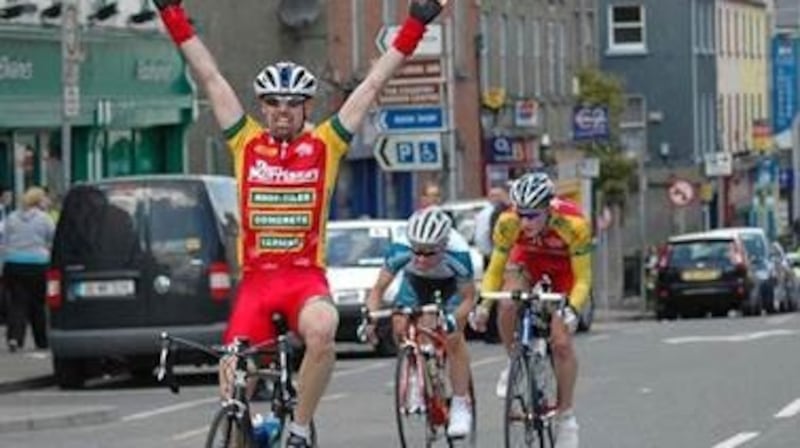Helen Bennett is standing in the doorway about to say goodbye when her eyes begin to well up. Just thinking about it, stuck in each passing moment, it doesn't take very much.
It's been like this for a few weeks now inside the house of the mother and father of the Irish rider wearing the green jersey in the Tour de France, for the first time in 31 years, already winning one stage, being inches away from a couple more, and still the exciting prospect of winning another on the magnificent Champs-Elysées.
In a moment just before, a neighbour pulls into the house opposite, and there's a child that cries out, "Come on Sam Bennett, come on Sam Bennett..." They were, his mother says, drawing up posters of Sam Bennett at school today.
Already too on every approach to Carrick-on-Suir, from the Tipperary, Waterford or Kilkenny side, there are signs and images that read "Allez Sam Bennett", "Bring it home Sam Bennett", many more in the shops and pubs still closed up in the face of Covid-19. These are hard times in the country town of just under 6,000 people, and Bennett's success in the biggest bike race in the world feels like a kind of magic.
This alone isn’t what has Helen Bennett close to tears; it’s also the quick journey she’s just taken through her oldest son’s cycling career, which more or less began not long after he learned how to walk. Aged just seven months, there was something about his natural balance and the strength of his legs already signalling him out, a career which has seen lots of tears of pride and despair along the way, long before Bennett got in on the act himself at Île de Ré after his victory in stage 10 of this year’s Tour.

Like when he won stage 7 of the famed Rás Tailteann, back in 2009, aged only 18, the 150km from Castlebar to Clara actually the furthest he'd ever ridden in his life, his final sprint for the line simply unmatched by his seriously senior rivals. Among the first to greet him that day was Helen, undergoing treatment for cancer at the time, and there wasn't a dry eye between them.
Or the following year, when in the bright December sunshine that came before the heavy snowfall of that Christmas, Bennett was out riding alone on the hills around Carrick-on-Suir when a passing driver, blinded by the winter light, hit him head-on and threw him off his bike and into the roadside ditch. He wasn’t wearing a helmet, and after his mother and father Michael followed him to Kilkenny Hospital, at one stage all they could hear from the nearby treatment room was “we’re losing him, we’re losing him...”
Or the year after that, having worked so hard to make a full recovery, when he arrived home from the Vélo Club La Pomme, in Marseille, with both knees crippled by injury, having ridden an ill-fitting time-trial bike. Just some of the moments behind the tears shed on a day like Île de Ré.
“Sam always had something for wheels, and a great fascination with speed,” says Helen. “I’d bring him around on the backseat of my bike, and he always loved that, no bother, just seemed to have that natural balance. Then when we got him his first bike, maybe one-and-a-half, two, he’d always be out on the paths, racing around, his little legs pumping away.”
Those being the paths around the cycling hotbed of Menen, the small town near Wervik, in Flanders in Belgium, where in 1989, the year before Sam was born, his father Mike secured a professional contract with the local club Eendracht Wervik FC. Having played eight seasons already with Waterford FC, his talents around midfield also earning him several appearances in the green jersey of the Republic of Ireland, this was the chance for Bennett senior to satisfy his ambition and desire to be the best he could, given his own naturally competitive instincts.
After Sam was born, in October 1990, Bennett played out four more seasons with Eendracht Wervik, before the then family of three returned home to Carrick-on-Suir, moving into the small riverside mews. It was just around the corner from where Bennett senior’s father lived and owned a shop, just a hundred metres from the South Quay – on the Waterford side of the River Suir, incidentally, though still inside the old Tipperary urban council boundary.
For the 1995 season Bennett senior managed Waterford FC, their second son Scott, five years Sam's junior, also born that year, although competitive cycling wasn't yet anywhere near the family. For Helen and Michael, who commutes daily from Carrick to his work in Cork, there were however lots of warning signs.
“When we got him his next bike, straightaway he wanted to take the stabilisers off, and I thought ‘well how far could he fall?’ because he did have such great balance,” says Helen. “Then when we moved back to Carrick-on-Suir, I’d have a few neighbours knocking on the door, telling me that Sam was doing wheelies on the bike, on the wall outside their house. And I thought, ‘well if I tell him to stop he’ll probably still do it anyway’. He was a bit of a daredevil like that too.”
Truth is, even at that age, the young Bennett didn't have many interests outside of his bike, least of all in any ball or team game. By the time he started secondary school at Comeragh College, just over the river, Bennett was already starting to make a name in the sport too.
************************

The Bennett house is the midway stop of a brief cycling tour around Carrick-on-Suir courtesy of Martin O’Loughlin, one of Bennett’s first coaches at the Carrick Wheelers cycling club, and one of his lasting friends and mentors.
A keenly competitive cyclist in his own heyday, O'Loughlin is currently national junior coach with Cycling Ireland, and also head of special needs education at Presentation Secondary School in Clonmel. Few people know the local cycling scene any better – and can also claim to have once beaten Bennett in a sprint.
Turning right out of the riverside mews, the only way is up, then onto the 2km climb that is Seskin Hill, first made famous in cycling by the Nissan Classic, quickly affording a panoramic over the town spread out below.
At the first turn, by pure chance, we pass Mags Power, out walking with her daughter Deirdre: it was her late husband Bobby Power, affectionately known as "the captain" at Carrick Wheelers, who died in 2011 aged 56, who gave Bennett his first real start in competitive cycling, at the underage mountain biking league on the trails around Seskin Wood.
“Sam really is a fusion of his mother and father,” O’Loughlin says. “Maybe the more emotional side from his mother, off his bike, and the competitive side of his father, on his bike, but either way he is a winner, just loves to win.
“They’d gone to Bobby when he was nine, because at that age Sam still wasn’t allowed to race on the road, so they raced here, a loop, maybe two laps, mostly single track, all very hilly. The problem was handicapping Sam. The race might last 25 minutes, they’d hold Sam back for 15, and he’d still catch them. He’d scare the life out of the others too, the way he passed them. So it’s right here, really, where it all started.
"Sam just wasn't into his team sports. I wouldn't say he was a loner, but he liked his own company. He started going out with Tara [who he married last year] when they were still quite young, and they became their own little community after that I suppose. Tara was a very talented high jumper, and a good sprinter in athletics too.
"I was still training most days then with the club. We were always aware of him, the likes of Bobby, and Paul Lonergan. He was always messing on a bike, doing wheelies up a hill, cycling down backwards, mad stuff like that.

“Ironically Sam was back on this hill, during the lockdown, as it was all within his 2km radius. So we’d be up here four, five days a week, which is where he did all his torque training, sitting in the saddle with as big a gear as possible, his legs hardly moving. Pure power training, really. There were no gyms open, so he essentially had to do all his gym work on his bike.”
Once that early talent was identified, Power recommended Bennett ride a few seasons with Kanturk cycling club, who were more competitive underage. Despite the certain myth that cycling has always been booming in Carrick-on-Suir, the so-called "second club", Carrick Wheelers RC, hasn't registered in almost 10 years. There were plenty of other influences around the town, not least in Seán Kelly, who in a simple twist of fate was the last Irish rider to wear that green jersey in the Tour before Bennett, winning it for the last of four times in 1989.
Kelly's only son is the same age as Bennett, and they became acquainted early on, long before Bennett got his first semi-professional contract with the An Post Seán Kelly team, under the tutelage of manager Kurt Bogaerts.
“There was a big boom after Kelly in the 1990s,” says O’Loughlin, his own son Micheál currently one of best young riders in Carrick. “We’d have the Cidona club mini bus, loaded with young riders most weekends, but what’s happened with safe guarding, and of course it’s right, is that you can’t take all these young fellas away anymore, whereas back then everyone would be off together in the mini bus.
“The masters side of cycling has got so big too, which is great in a way, but very few of the guys I race have their kids still racing, because they’re still racing themselves.”
The road continues on up the hill, Slievenamon now clear off in the near distance: “North, south, east or west, depending on what way the wind or rain is blowing, there are lots of good options for cycling around here,” says O’Loughlin, before pointing out a reminder of some of the dangers of it too. At the top of the Seskin, before the road heads out to Curraghduff, in Waterford, where Kelly was born and raised, there’s a small monument at the spot his older brother Joe was killed, on August 11th, 1991.
It was Joe who first introduced Kelly to cycling as a youngster. He had just completed a 100-mile charity cycle around Carrick-on-Suir when he was hit by a car and killed. Naturally devastated, Kelly returned home for the funeral, but could hardly have made any sense of it: he’d taken more risks and survived more near-misses in cycling than he could ever remember, and yet his brother just happened to be in the wrong place at the wrong time. Three days later Kelly was back on his bike, riding a criterium in Belgium.
From there, O’Loughlin takes the tour back into Carrick-on-Suir on the road back past Curraghmore House, also home to the All Together Now festival, and the road where Bennett began to perfect his pure sprinting skills.
"It's a perfectly straight stretch, slightly downhill, and after 100km or so of racing, we would race this flat out. That started when he was around 15, 16. He was really pissed off that he wasn't winning races. You know, he really likes winning. There were a few guys on the scene, like Philip Lavery, who at that stage were beating him regularly.
“Sam had this love of aggressive riding, attack the f**k out of it, but for someone like him, a more power-based rider, that wasn’t always the best tactic. Along this road, I would do a threshold ride, Sam would be on my wheel, would jump me to get up to his 200m sprint, then I’d jump him again. That all improved his sprint ability as well. After that he just got better and better.”
Much of the area around the town is a natural training ground, even if some of the road surfaces beg to differ. There still isn’t, or likely will ever be, a Carrick Wheelers clubhouse, the car park at SuperValu still the natural meeting point after all these years.
“The club is going well enough, we’ve maybe 50 members, and at the national youth track championships, last weekend, had only two riders, and they brought home five medals,” says O’Loughlin. “I think cycling goes well in a recession, similar to say marathon running, say from a participation point. But like any sport it’s also an entertainment business and it hasn’t been in headline news over here, and so hasn’t brought in much sponsorship
“I do think Sam Bennett is the start of something big. People now know him, his brand, his success, and it’s up to Cycling Ireland to capitalise on that, because the overall numbers are up. I’d certainly be optimistic.”

************************
It was sometime during his early teenage years when Helen and Michael Bennett realised their son Sam was getting a lot more serious about his cycling.
“He’d be talking about the price of a new bike, around Christmas,” says Helen. “We’d say that sounds like an awful lot, and turns out he was only talking about the frame. The frame?
“But we love watching all of his races, just not always together. We were all set to go to the start in Nice this year too, the holidays booked, then on to Paris. But not now, but we do have lots of holiday vouchers for next year.”
That support was unwavering, especially at the lowest points, one of which came mid-season, 2013. Resigned to returning to college if things didn't improve, Bennett won the fifth stage of that year's Tour of Britain, finishing in Caerphilly, marking perhaps the last turning point in his decision not to turn back.
O’Loughlin had contacted practically every professional team, looking for a contract if Bennett won a stage, and NetApp–Endura (later Bora–Hansgrohe) were the only ones to reply.
“Sam found himself at a very low ebb that summer, and there was nothing much people could say. He was asking himself, ‘is this the sport for me? Do I need to go back to college?’ He was only making pocket money, really.”
His first Tour de France start in 2015 was cut short by illness and injury, his second start a year later marred by another crash on stage 1, although he did make it to the Champs-Élysées in this one, in 174th position, the last rider to finish. After three stage wins in the 2018 Giro, and two more in the 2019 Vuelta, it was only after joining his own self-proclaimed dream team in Belgian outfit Deceuninck-QuickStep for the 2020 season that he was free to chase stage wins in the Tour.
The question of winning in cycling is never too far away from the subject of doping, only Bennett’s career has always stayed a safe distance away.
“When Sam was 18, 19, he was still texting me, wanting to double check everything,” says McLoughlin. “If he’s sick, he’s still so wary, he doesn’t even like taking vitamin C, so it’s just not something he’s ever even gone near.
“For sprinters, it’s a different ball game. Last Sunday, he finished five minutes from the time limit, on his hands and knees. That’s not a rider taking anything they shouldn’t be taking. Same with the time-trial, he’s not going to be in the mix there.
“Sam was always fast, but it was only when the races got bigger and bigger, that he showed he could mix it with the best in the world. He’s definitely improving too. It’s his first year with Quickstep and now that he’s winning they will have more faith in him, target more races for him. And so much about sprinting in cycling is confidence, and he’s got more of that now.”
Born with it, some might say.






















